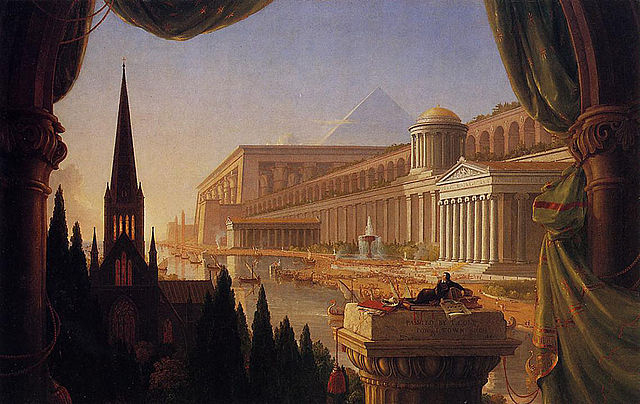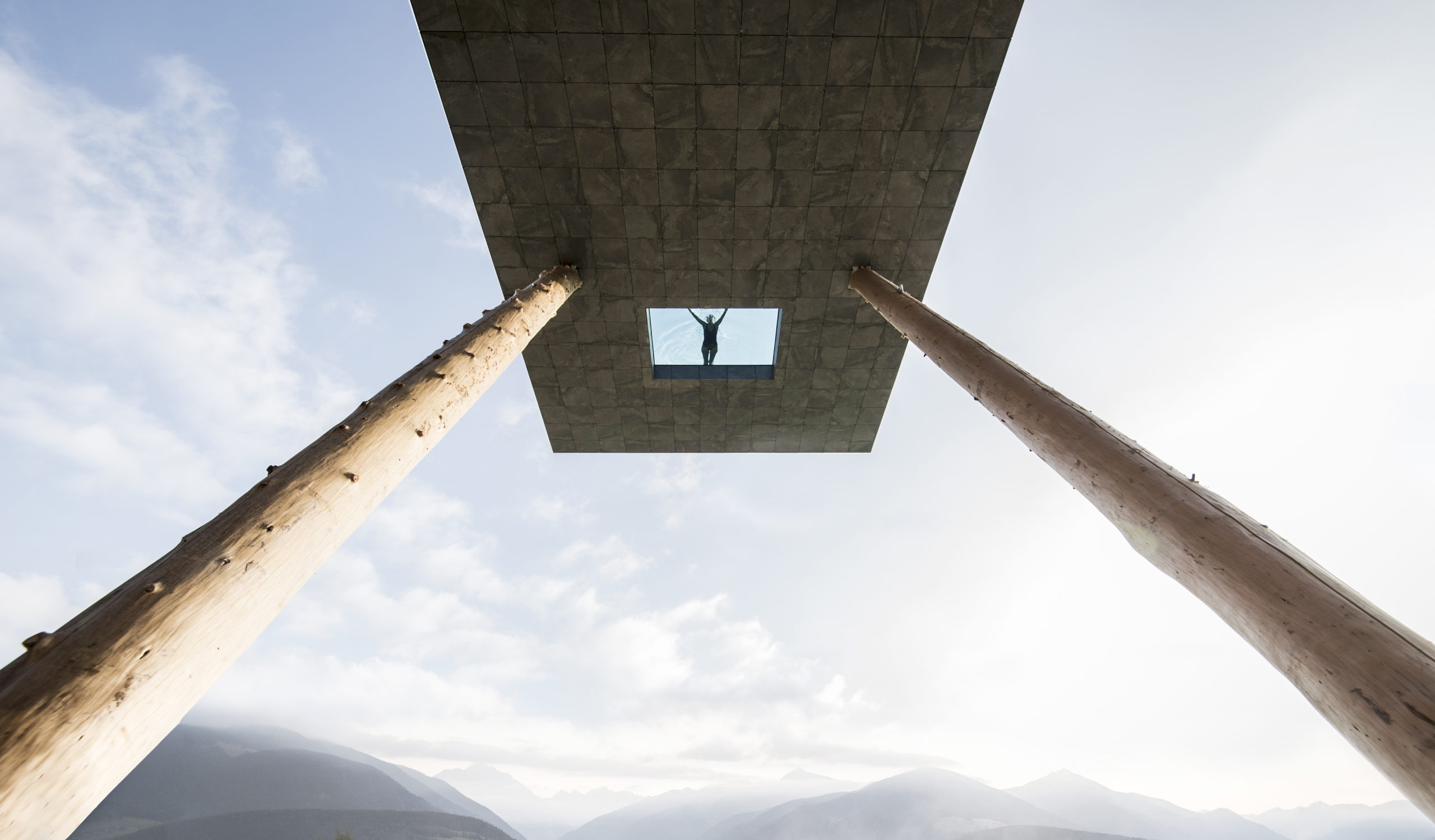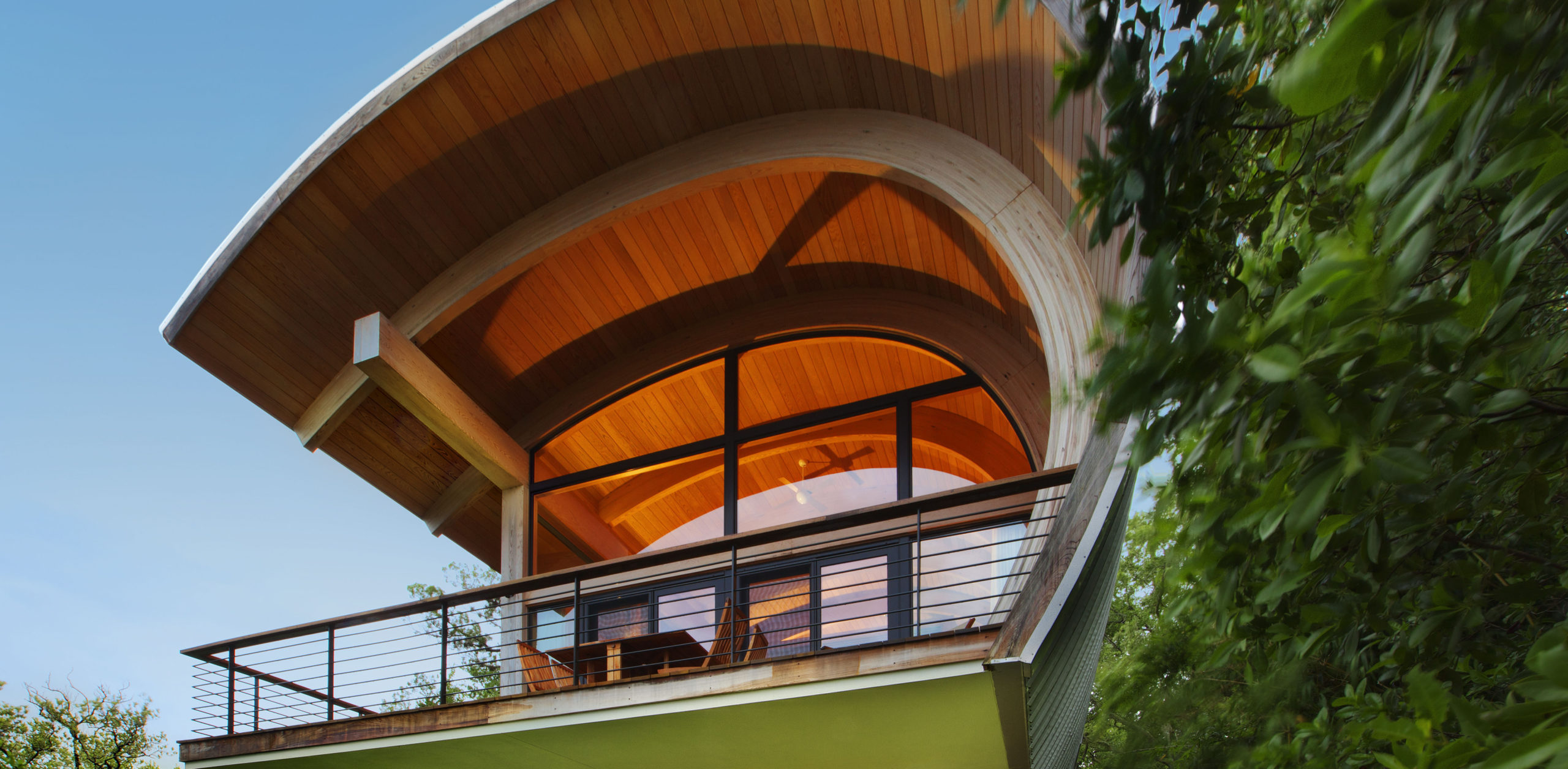Architects: Want to have your project featured? Showcase your work through Architizer and sign up for our inspirational newsletters.
Architecture school is difficult. In one sense, this is as it should be. Once you’re out in the field as a licensed architect, there is no bluffing your way through designing a building, so you really shouldn’t be able to float through your degree either. However, as with all things, there is a limit. Students should not face unworkable schedules that force them to sacrifice their sleep and overall health. Just recently, an Architizer article by Samantha Frew lamented the ubiquity of “all nighters” among architecture students. This piece kicked off a firestorm of debate on Facebook, with some commentators echoing the author’s call for better school-life balance and others arguing, to put it crudely, that it is what it is – architecture is a profession where only the strong survive.
Reading this debate, I became interested in what architecture education looked like in years past. In Ancient Greece, say, when Parthenon designers Iktines and Callicretes first learned their trade, did they pull all-nighters? What about in 1920s Germany, when waifish students with ruffled hair and sad eyes attended lectures by Walter Gropius at the Bauhaus? Did these stylish young people also sit hunched over proposals until the early morning hours? I always imagined them ending their nights at the cabaret…
These were the questions I asked myself as I perused the testy Facebook comments on Ms. Frew’s article. Luckily, I was not the first person to ask these questions. The history of architecture education has been carefully documented by scholars. Interestingly, when it comes to formal architecture education in schools — rather than something like an apprenticeship model — that history is not as long as you might think. The first school dedicated to the explicit training of architectural students was the Académie d’Architecture in France, which opened on 3 December 1671, during the long reign of Louis XIV. It lasted just over 100 years, until it was dissolved along with other monarchist institutions during the revolution. However, its influence on subsequent architecture education was profound. The École des Beaux Arts, which was founded in 1807 and remains a leading institution, modeled its curriculum on the earlier school.
The history of the Académie d’Architecture is surveyed brilliantly in Alexander Griffin’s accessible 2020 book, The Rise of Academic Architectural Education. If you want a comprehensive look at the origins of academic architectural training, we recommend picking up a copy. For a briefer look at what life was like for these early architecture students, here are our top takeaways from the book.
The first academic architecture students didn’t have grades or even assignments.

Frontspiece of 1675 book issued by the Académie titled “Cours d’Architecture.” Image via Wikimedia Commons
The Académie d’Architecture eventually grew into a powerful institution for practical education, but its original function was mostly ideological and propagandistic. Louis XIV founded the Académie as a place where architectural masters could research and discuss the principles of Classicism. The Classicism of this period was rooted in Rationalism, the official philosophy of the regime. The idea was that buildings, like the organization of the French state, could be designed in a way that perfectly aligned with divine principles of Reason. Like Plato, Louis XIV’s architects were searching to bring their practice more in line with heavenly forms.
The academicians would use their findings to advise the royal builders, ensuring that they followed Classicist principles. (Interestingly, this Classicism didn’t always utilize Greco-Roman forms — the designers of Versailles certainly didn’t always do this. The point was to follow Classical principles of harmony and balance). In addition, the academicians would promote the royal style in weekly public lectures. The first architecture students were thus simple attendees of the lectures, like auditors. Their practical training took place outside the academy, which was a temple to high theory.
The Académie was a direct challenge to the medieval guild system that had previously ruled the architectural profession.
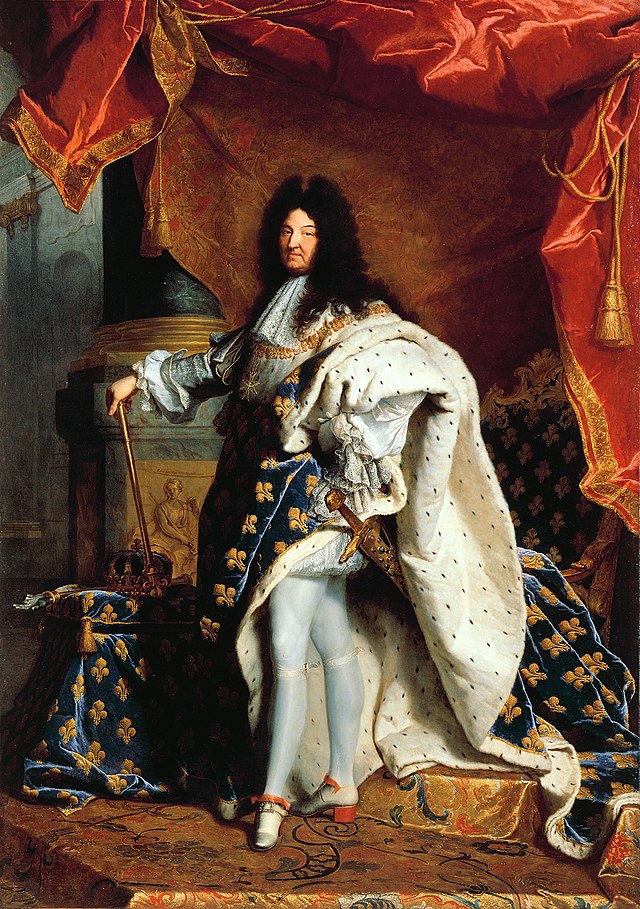
Painting of “The Sun King” Louis XIV by Hyacinth Rigaud, 1700. Image via Wikimedia Commons.
It is impossible to disentangle the early history of the Académie from the regime of Louis XIV and his political project of unifying disparate elements of the French kingdom under his own absolutist administration. Indeed, the Académie was but one facet of Louis XIV’s attempts to push away medieval institutions in favor of a centralized, “Enlightened” absolutism. As his nickname, the Sun King, made clear, he saw himself as the sun around which all other elements of the state revolved. Like the sun’s position in the cosmos, Louis believed his place in the state was divinely ordained, part of a rational, harmonious natural order.
Louis XIV’s ambition is embodied in his most famous project and lasting monument, the Palace of Versailles. This 700 room structure was many things: a symbol of divine authority, a new center of cultural and social life in France, and an ingenious way to break the back of aristocratic power by drawing nobles away from their estates with the allure of wine and gossip. It was also considered a showroom for French craftsmanship at a time when the king’s chief advisor, Jean-Baptiste Colbert, was shifting the economic strategy of the kingdom toward manufacturing.
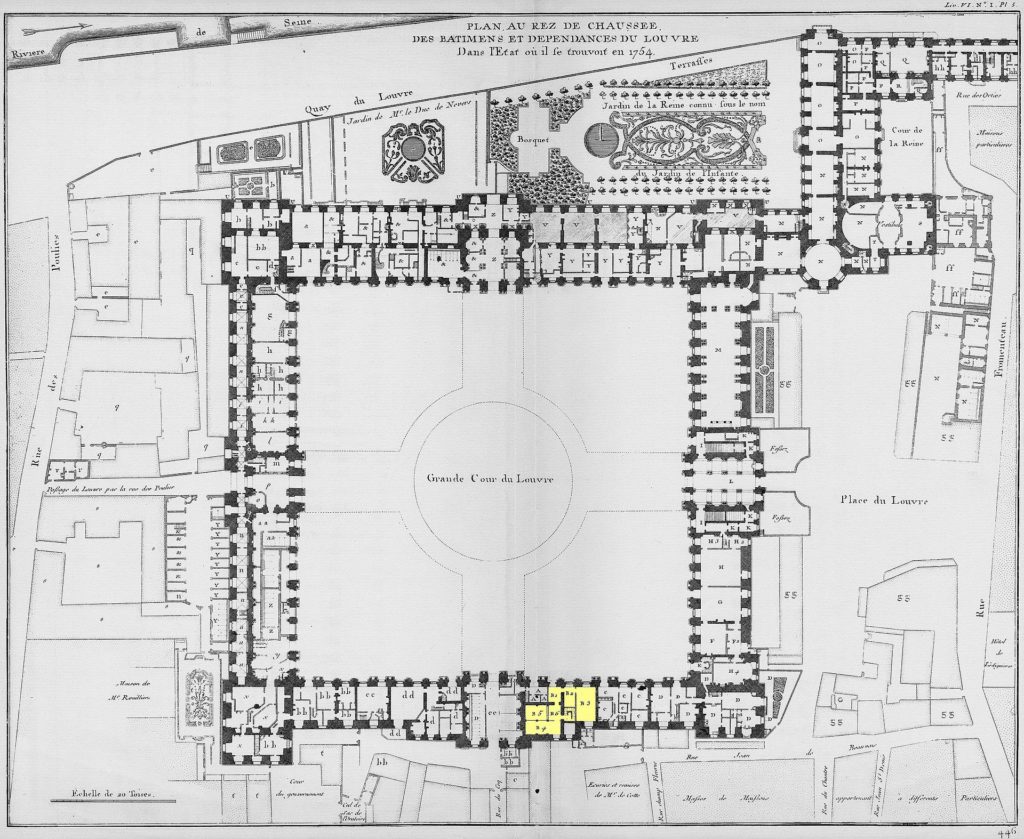
The Académie was housed within the Louvre. Here is a 1754 plan of the Louvre with the rooms of the Académie highlighted in yellow. Via Wikimedia Commons.
It was decided by Colbert and others that the development of Versailles required a team of artists and artisans loyal to the king rather than to their own local guilds. He developed a workshop for practical arts known as the Manufacture Royale des Meubles de la Couronne, or the Gobelins for short after their first leader, Jean Gobelins. Here, everything from painting to sculpture to engraving and tapestry were taught and practiced, supplying the king with lavish objects to decorate his palaces. Importantly, the Gobelins provided artisans with an alternative education and accreditation system to the guilds, with the benefit of working directly for the king.
In addition to the Gobelins, Louis XIV created a series of academies for the “higher” arts, each of which helped establish and promote a French royal style that with in line with the principles of Classicism: the Académie de Danse (1661), Académie des Inscriptions et Médailles (1663) (after 1716 known as the Académie des Inscriptions et Belles-Lettres), Académie des Sciences (1666), Académie de France à Rome (1666), and the Académie de Musique (1669). Last but not least was the Académie d’Architecture, which was first imagined as an incubator for architectural thought that would inform the practices of royal builders and decorators. Like the Gobelins, the Académie helped the king resist the power of provincial guilds by establishing a royal style that was promoted as objectively superior to various local building practices.
The history of the Académie was dominated by a debate between Rationalists and Empiricists.

Versailles was designed according to the Rationalist principles of harmony, balance, and symmetry. Restraint, however, was not one of the principles taught by the Académie. Photo by ToucanWings via Wikimedia Commons.
Rationalism was the name of the game when it came to the artistic, philosophical, and literary life of Louis XIV’s court. As Griffin explains, “The Académie’s ideology initially emphasized the view that God had created the universe on the basis of geometrical laws, and that these laws could be comprehended and applied to architecture.” However, things changed in the 18th century, as empiricist philosophers from the English speaking world like George Berkeley and David Hume shifted the focus of philosophical inquiry onto the individual thinking subject and their impressions of the outside world. Enlightenment, then, became a method of challenging received norms rather than justifying them, a cultural shift that had profound implications at all levels of society.
Griffin: “Whilst those in charge at the Académie desired to continue a distinct rationalistic theoretical approach and architectural style, many students and prominent architectural critics outside the academic system ridiculed their perceived anarchic viewpoint until eventually, warring words turned to actions.” What this meant in practice was entertaining a more diverse set of perspectives on architecture as well as politics. Architects, like others in France, were frustrated by a narrow vision of their work which held that their chief aim must be the glorification of the regime. As the eighteenth century advanced, anti-monarchical sentiment grew and efforts were made to remove all of the academies from royal control. Ultimately, this trend culminated in the revolution, which saw both the overthrow of the French monarchy and the dissolution of the Académie.
In addition to studying at the Académie, prospective architects would pursue hands-on study at an atelier under a renowned Patron.
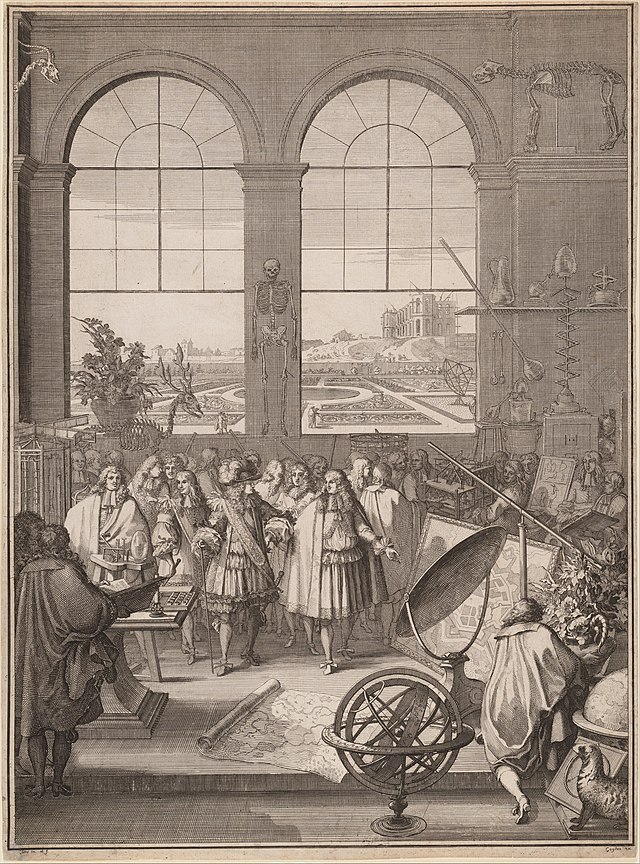
Louis XIV visiting the Royal Academy of Sciences, 1671. Engraving via Wikimedia Commons.
While the Académie, in its early days, was a kind of royal think tank that also offered public lectures, things shifted in the early 18th century, when the Académie became an elite training ground for architects. At first, admission to the Académie was capped at six students, making it an exclusive institution indeed. Things expanded somewhat from there, but the school always carried a mystique of elitism. While there were many places where a builder could hone their craft, only the Académie had institutional cache.
Even as the Académie became a teaching institution, the emphasis was always on theory, with education taking place solely inside a lecture hall. The nuts and bolts of architectural training, including instruction in draftsmanship and other skills, took place in the studios of elite architects known as Patrons. Each Patron effectively ran their own architectural school in parallel to the instruction students were receiving at the Académie.
Competition among the students was fierce. Beginning in 1720, the Académie began hosting yearly contests. As Griffin explains, “By the end of the seventeenth century, the Grand Prix had become the highlight of the year in French architectural education for nearly two and half centuries and the most important system by which more gifted students were taught and their abilities measured.” There was never any intention to build the designs for the Grand Prix competitions; these designs were solely a means by which students could showcase their skills.
Like many other aspects of the Académie’s curriculum, student competitions live on today in architectural schools throughout the world.
Architects: Want to have your project featured? Showcase your work through Architizer and sign up for our inspirational newsletters.
Cover Image: Thomas Cole, “The Architect’s Dream,” 1840. Via Wikimedia Commons.
